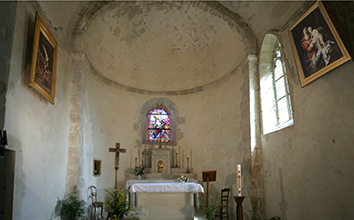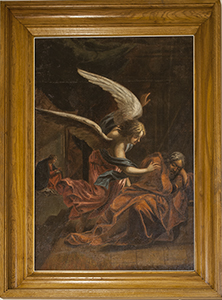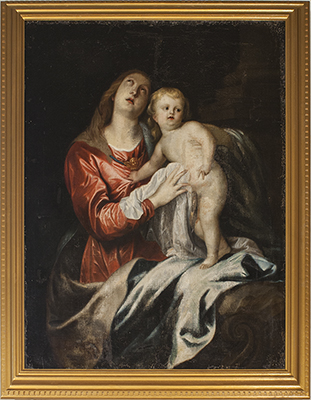|
Paintings
Two
fine paintings hang in
the choir of Brux church, a Virgin and Child from the workshop of Van
Dyck (1599-1641), and The Dream of Joseph, modelled on an original by
Simon Vouet (1590-1649), now known only from an engraving by his
son-in-law Michel Dorigny dated 1640 (a copy of which hangs in the
Musée des Beaux Arts in Nancy).
The paintings have been the subject of professional restoration and
their return to the church early in 2012 was marked by both civil and  religious ceremonies. Since 1993
they had been
transferred to the
workshop of conservation studies in rue Tolbiac, Paris 13e, part of the
University Paris 1 Panthéon-Sorbonne, where under the expert
supervision of Professor William Whitney the very dirty and damaged
canvases were cleaned, re-backed , repaired and retouched, in places
quite extensively, before being lightly varnished to protect the fully
restored artwork. Following their discreet removal back to Brux in
November 2011they were reframed in the workshops of artisan craftsman
Bernard Rousseau, in frames based closely on the original models, one
gilded, the other in a bronze patina finish. religious ceremonies. Since 1993
they had been
transferred to the
workshop of conservation studies in rue Tolbiac, Paris 13e, part of the
University Paris 1 Panthéon-Sorbonne, where under the expert
supervision of Professor William Whitney the very dirty and damaged
canvases were cleaned, re-backed , repaired and retouched, in places
quite extensively, before being lightly varnished to protect the fully
restored artwork. Following their discreet removal back to Brux in
November 2011they were reframed in the workshops of artisan craftsman
Bernard Rousseau, in frames based closely on the original models, one
gilded, the other in a bronze patina finish.
The first painting shows the Christ child standing on the lap
of
the Virgin, his head turned towards the viewer and his arm
outstretched; while the head of Mary is turned upwards to heaven in
grateful ecstasy. In the painting devoted to Joseph's dream the
composition is dominated by the wings of an angel who touches Joseph on
the shoulder in order to advise him to accept the divine origin of the
child Mary is carrying (Matthew -I, 20).
Prior to restoration, the wings and outline of the angel were the only
parts of this painting still clearly visible under the grime of
centuries, while the Van Dyck canvas  was badly discoloured and had
suffered at least one tear in the fabric. The St Joseph was placed on a
new stretcher, cleaned and varnished; the Virgin and Child was also
placed on a new sub-frame, masticated and retouched. Thanks to the work
of Professor Whitney and his students, these restored pieces may now be
appreciated by a much wider audience, having played their part in the
instruction of future restorers of other works of art.
was badly discoloured and had
suffered at least one tear in the fabric. The St Joseph was placed on a
new stretcher, cleaned and varnished; the Virgin and Child was also
placed on a new sub-frame, masticated and retouched. Thanks to the work
of Professor Whitney and his students, these restored pieces may now be
appreciated by a much wider audience, having played their part in the
instruction of future restorers of other works of art.
Little is known of the history of these paintings, but they
are
of such quality that they must have come into the possession of the
church from a distinguished source, and (following the suggestion of an
anonymous writer in the Affiches
du Poitou dated 5 April 1913) it is
widely assumed that they hung originally in the Château d'Épanvilliers,
and were given to the Curé of Brux for safe keeping at the time of the
French Revolution. The same source indicates that a member of the
Montalembert family of Épanvilliers was at one time
'Chef de la Garde Écossaise', and may have obtained the Madonna
directly from the
workshop of Van Dyck during a period spent in England, where Van Dyck
was an appointed court painter to King Charles I. Certainly the
painting now hanging in Brux is closely comparable to authenticated
versions by the master himself, to be seen in the respective galleries
of the Fitzwilliam Museum
in Cambridge and of Dulwich College in south
London. However Daniel Bourdu, Conservateur délégué des Antiquités et
Objets d'Art at the Direction régionale des Affaires culturelles de
Poitou-Charentes, an expert who has taken a close interest in the
history of these works, has expressed the opinion that both paintings
are more likely to be copies made in the second half of the 17th
Century.
closely comparable to authenticated
versions by the master himself, to be seen in the respective galleries
of the Fitzwilliam Museum
in Cambridge and of Dulwich College in south
London. However Daniel Bourdu, Conservateur délégué des Antiquités et
Objets d'Art at the Direction régionale des Affaires culturelles de
Poitou-Charentes, an expert who has taken a close interest in the
history of these works, has expressed the opinion that both paintings
are more likely to be copies made in the second half of the 17th
Century.
The earliest clear record of their presence in the church is
a
photo of the Van Dyck sent in 1938 by the then Curé,
Abbé Bisson, to a
local parishioner as a greeting card. Neither painting appears on the
inventory of 1905, suggesting that at this time they were still held
privately (probably by the Curé rather than the Montalembert family,
who had been dispossessed of their riches in 1792). This means that the
question of their present ownership cannot be established beyond doubt:
suffice to say that they belong to Brux and form an integral part of
its ancient church's heritage.
Click
to enlarge the pictures
Text established
by Gavin
Brown - 2012
|
![]()